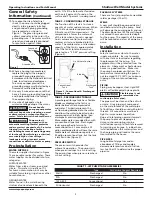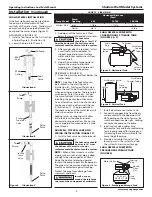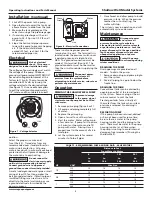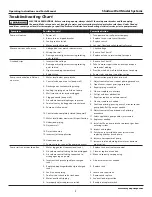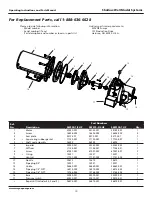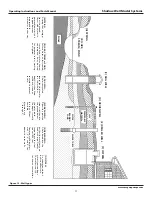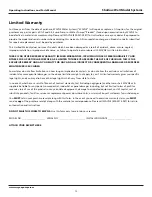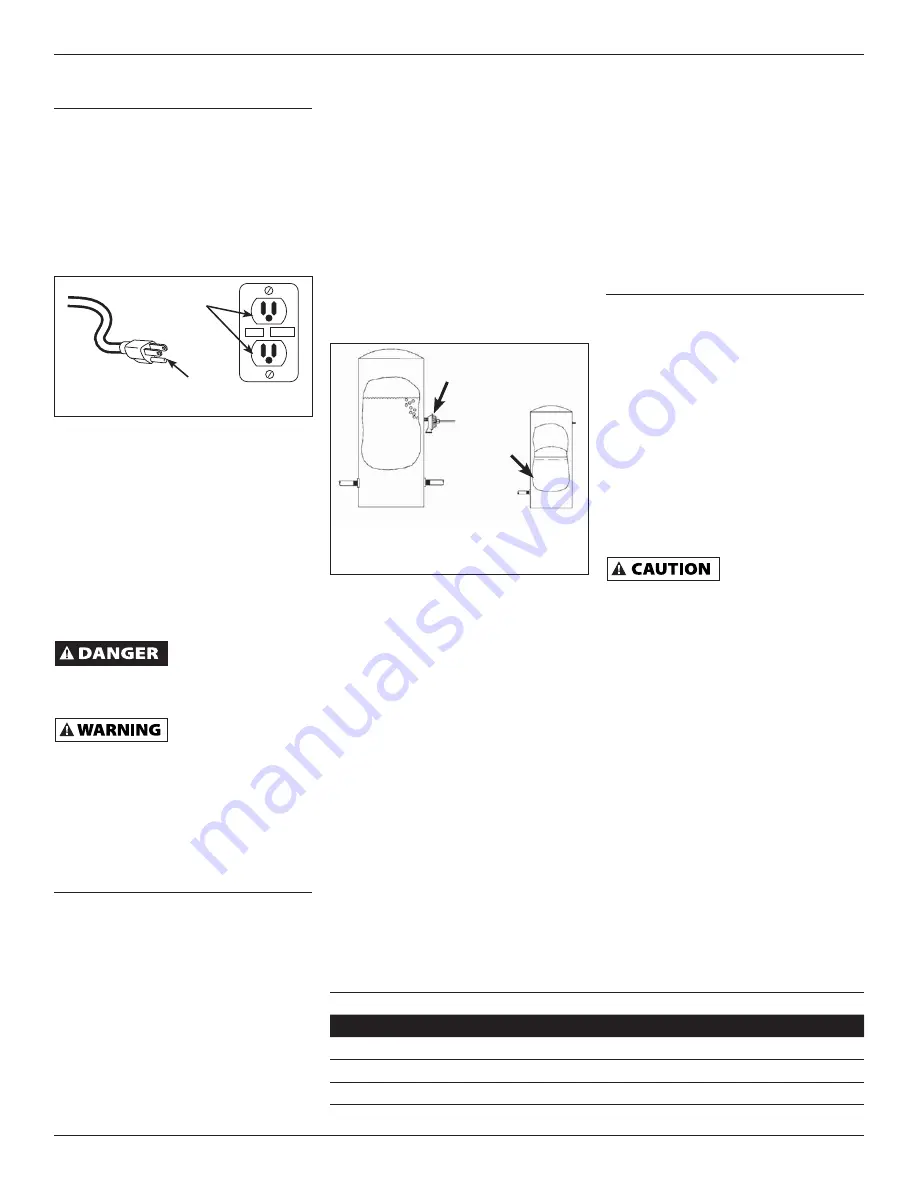
2
19. To reduce the risk of electrical
shock, the pump should be plugged
directly into a properly installed
and grounded 3-prong grounding
type receptacle, as shown in
Figure 1. The green (or green and
yellow) conductor in the cord is the
grounding wire. The motor must be
securely and adequately grounded
for protection against shock.
20. Where a 2-prong is encountered,
replace the plug with a properly
grounded 3-prong receptacle in
accordance with the National Electrical
Code, local codes and ordinances.
To ensure a proper ground, the
grounding means must be tested by a
licensed or certified electrician.
21. Use only 3-wire extension cords that
have a 3-prong, grounding type plug,
and 3-pole receptacles that accept
the equipment plug.
22. Use wire of adequate size to
minimize voltage drop at the motor.
Do not handle
pump or pump motor
with wet hands, when standing on a wet
or damp surface or when standing in
water. Fatal electrical shock could occur.
Pump motor is
equipped with an
automatic resetting thermal protector
and may restart unexpectedly. Protector
tripping is an indication of motor
overloading because of operating pump
at low heads (low discharge restriction),
excessively high or low voltage,
inadequate wiring, incorrect motor
connections or defective motor or pump.
Pre-Installation
WATER SUPPLIES
The water supplies illustrated in Figure
13 are possible sources for water. These
water supplies can be divided into two
categories:
SURFACE WATER
Water from a lake, stream, pond and
cistern. This water is usually not fi t
for human consumption, but may be
suitable for washing, irrigation or other
household uses.
GROUND WATER
Water found in the water bearing
stratum at various levels beneath the
General Safety
Information
(Continued)
earth. Of all the fresh water found on
earth only 3 percent is found on the
surface and 97 percent is underground.
TANKS - CONVENTIONAL STORAGE
The function of the tank is to store a
quantity of water under pressure. When
full, the tank contains approximately
2/3 water and 1/3 compressed air. The
compressed air forces the water out
of the tank when a faucet is opened.
An air volume control automatically
replaces air lost or absorbed into the
water. The usable water, or drawdown
capacity, of the tank is approximately
1/6 of the tanks total volume when
operated on a “20-40” pressure setting
(Figure 2).
TANKS - PRECHARGED STORAGE
A precharged storage tank has a fl exible
bladder or diaphragm that acts as a
barrier between the compressed air
and water. This barrier prevents the
air from being absorbed into the water
and allows the water to be acted on by
compressed air at initially higher than
atmospheric pressures (precharged).
More usable water is provided than with
a conventional type tank. Precharged
tanks are specifi ed in terms of a
conventional tank. For example, a 20
gallon precharged tank will have the same
usable water or drawdown capacity as a
40 gallon conventional tank, but the tank
is smaller in size (Figure 2).
PRESSURE SWITCH
The pressure switch provides for
automatic operation. The pump starts
when pressure drops to a cut-in setting.
The pump stops when pressure reaches a
cut-out setting.
TEST
RESET
Grounded Pin
Grounded
Outlet
Figure 1
PACKAGE SYSTEMS
There are four jet pump/tank assemblies
sold as packages (Chart 1).
WELLS
A new well should be pumped clear of
sand before installing the pump. Sand
will damage the pumping parts and seal.
The draw-down level of the well should
not exceed the maximum rated depth
for the pump. The capacity of the pump
will be reduced and a loss of prime may
occur.
Installation
LOCATION
Select a location as close to the water
supply as possible. Be sure to comply
with any state or local codes regarding
the placement of the pump. The
equipment must be protected from the
elements. A basement or heated pump
house is a good location. Make sure
the pump has proper ventilation. The
temperature surrounding the pump is
not to exceed 100° F (40°C) or nuisance
tripping of the motor overload may
occur.
PIPING
Piping may be copper, steel, rigid PVC
plastic or fl exible polyethylene plastic.
Flexible pipe is not
recommended on
suction pipe (inlet pipe).
The pipe must be clean and free of rust
or scale. Use a pipe joint compound
on the male threads of the metal pipe.
Tefl on® tape should be used with plastic
threads. All connections must be air
tight to insure normal operation.
Slope all inlet piping upwards towards
the pump to prevent trapping air.
Unions or hose couplings can be
installed near pump to facilitate removal
for servicing or storage. A rubber hose
installed between the water system and
the house piping will reduce the noise
transmitted to the house.
PIPE SIZES
Long horizontal pipe runs and an
abundance of fi ttings and couplers
decrease water pressure due to friction
loss. See Chart 2 to determine the proper
pipe size.
www.waynepumps.com
Operating Instructions and Parts Manual
Shallow Well Model Systems
Figure 2 - Conventional & Precharged
Storage Tanks
Precharged
Tank
Conventional
Tank
Bladder
Air Volume Control
CHART 1 - JET PUMP/ TANK ASSEMBLIES
Type
Air Volume Congrol Required
Well X
Precharged
No
PCA
Precharged
No
12P & 30P
Conventional
Yes
FX Horizontal
Precharged
No
Summary of Contents for Shallow well model
Page 6: ...6 Operating Instructions and Parts Manual Shallow Well Model Systems www waynepumps com Notes...
Page 7: ...7 Operating Instructions and Parts Manual Shallow Well Model Systems Notes www waynepumps com...
Page 8: ...8 Operating Instructions and Parts Manual Shallow Well Model Systems www waynepumps com Notes...


